Here is a unique and truly original destination, as there is just one local charter company with a single catamaran. The archipelago offers everything you could wish for: sublime beaches, coral reefs with multi-coloured inhabitants, anchorages where you will always be alone and incredible colours...
Logbook
A little paradise situated in line with the Bahamas and north of the Dominican Republic, the Turks and Caicos Islands are an archipelago of coral islands just surfacing from a turquoise ocean. They are perfectly protected from mass tourism, and for the several years now have offered Hollywood stars a Caribbean retreat sheltered from view, and sailors a new secret exotic destination.
Caicos Sailing takes you aboard a catamaran to discover the forty or so islands which form the archipelago. Only eight of them are inhabited. As you can imagine, you won't be disturbed by the neighbours at anchor. Kilometres of flour-white sandy beaches are bordered by transparent waters in which swim all the fauna of the spectacular coral reefs: turtles, dolphins, lagoon sharks, barracudas and multi-coloured fish. A constant trade wind rocks the boat, which slips unconstrained over the Caicos Bank, sheltered from the Atlantic swell by the reef further offshore. The land, rather arid, can be discovered on foot, by bike or in a golf caddy. The eagles, flamingos, iguanas and pelicans approach confidently, just like the hump-backed whales which pass each year between the Turks and the Caicos to go and reproduce further south.
Your private catamaran will anchor in the mangrove or be beached at the foot of the coconut trees, in a succession of idyllic anchorages in total harmony with nature.
Allow yourself to be pampered by an attentive crew, and appreciate the magic of the tropical nights, after a lavish meal aboard, or a barbecue on the beach.
Practical info
- Situation:
In the Caribbean Sea
Miami: 930 km
Dominican Republic: 160 km
Bahamas: 48 km
- Access:
International airport: Providenciales (PLS)
No direct flights from Europe. The easiest (without a night stopover) is the transfer via Miami.
From the USA: American Airlines: 2 flights daily from Miami, 1 flight daily from New York JFK, 3 flights per week from Boston. US Airways: Daily flights from Charlotte and Philadelphia. Delta Airlines: Flights from Atlanta.
From Canada: Air Canada flies from Toronto and Montreal.
From Europe: British Airways: flights from London via Nassau.
- Formalities:
The Turks and Caicos are a British overseas crown territory. Valid passport, no visa required for EEC residents. Be careful with the transfer in the USA which requires a biometric passport or a waiver visa.
- Climate:
With a hot, dry, tropical climate, there are few rainy days (around 30 days’ rain per year). Temperatures are very pleasant all the year round, with an average of 29°C. The winter season, between November and May, is particularly mild. The summer season, between June and October, is hotter and wetter. The region has fewer hurricanes (between July and October) than the West Indies, further south.
- And also...
Money: US Dollar
Language: English
Many restaurants, bars and supermarkets on Providenciales, rarer on the other islands.
Usual tip: 15%
Itinerary
Day 1
Providenciales:
The most developed island, with its international airport 1h20 from Miami, it is the ideal departure point for a cruise. Shops, a supermarket and even a French ‘boulangerie' allow good provisioning.
The most developed island, with its international airport 1h20 from Miami, it is the ideal departure point for a cruise. Shops, a supermarket and even a French ‘boulangerie' allow good provisioning.
Day 2
North Caicos:
The greenest of the archipelago's islands, it has nature reserves which are home to colonies of flamingos. Popular with walkers.
The greenest of the archipelago's islands, it has nature reserves which are home to colonies of flamingos. Popular with walkers.
Day 3
Middle Caicos:
The biggest island, very rocky, creeks with translucent water and limestone caves once inhabited by the Taïno Indians, which harbour numerous relics still to be discovered.
The biggest island, very rocky, creeks with translucent water and limestone caves once inhabited by the Taïno Indians, which harbour numerous relics still to be discovered.
Day 4
West Caicos:
Still uninhabited (but not for much longer, as a Ritz-Carlton palace is being built), it is wonderful for diving, with a particularly impressive sloping reef. Diving holidays can be organised here on request.
Still uninhabited (but not for much longer, as a Ritz-Carlton palace is being built), it is wonderful for diving, with a particularly impressive sloping reef. Diving holidays can be organised here on request.
Day 5
East Caicos:
Deserted nowadays, (except for the turtles which come to lay their eggs on the wonderful north beach), it harbours the remains of bygone human presence: petroglyphs, paths snaking into the bush and the ruins of Jacksonville, the now-abandoned sisal planters' town.
Deserted nowadays, (except for the turtles which come to lay their eggs on the wonderful north beach), it harbours the remains of bygone human presence: petroglyphs, paths snaking into the bush and the ruins of Jacksonville, the now-abandoned sisal planters' town.
Day 6
South Caicos:
The most local island; it lives on fishing and conch shells, and harbours numerous British and Bermudian colonial architectural treasures.
The most local island; it lives on fishing and conch shells, and harbours numerous British and Bermudian colonial architectural treasures.
Day 7
Grand Turk:
On the other side of the Colombus Passage, where the hump-backed whales pass between January and April, it is the country's administrative capital. Its 19th century houses, still standing and restored after the passage of two hurricanes last year, are a colourful evocation of the colonial Caribbean.
On the other side of the Colombus Passage, where the hump-backed whales pass between January and April, it is the country's administrative capital. Its 19th century houses, still standing and restored after the passage of two hurricanes last year, are a colourful evocation of the colonial Caribbean.
Day 8
Salt Cay:
Exploited for its internationally famous salt for a long time, its scenery is modelled by the salt marshes which are nowadays the favourite habitat for all kinds of rare birds: terns, frigate birds, herons and flamingos.
Exploited for its internationally famous salt for a long time, its scenery is modelled by the salt marshes which are nowadays the favourite habitat for all kinds of rare birds: terns, frigate birds, herons and flamingos.
 Vote for your favorite multihulls!
Vote for your favorite multihulls! 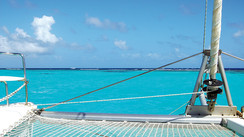
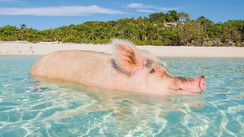
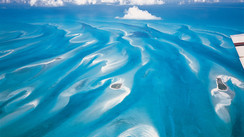
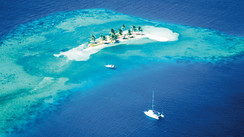
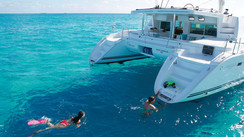
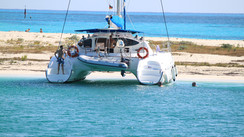
What readers think
Post a comment
No comments to show.